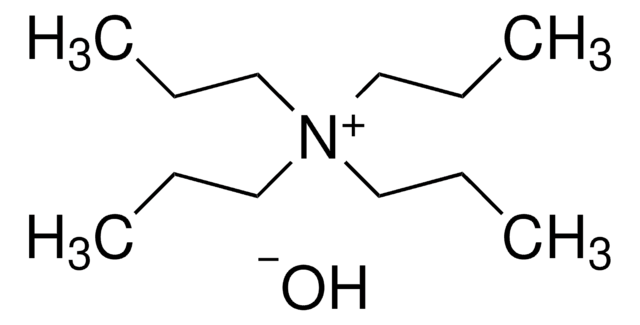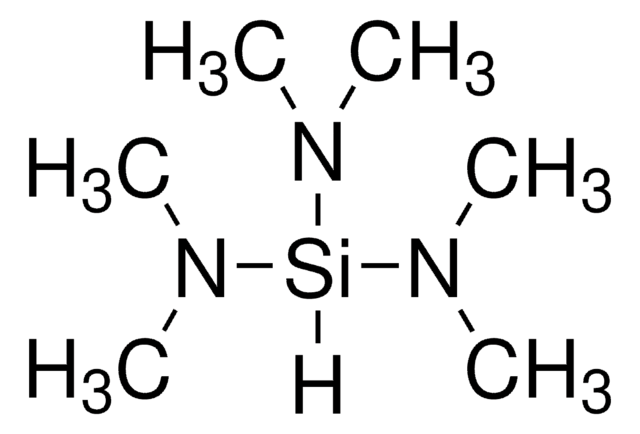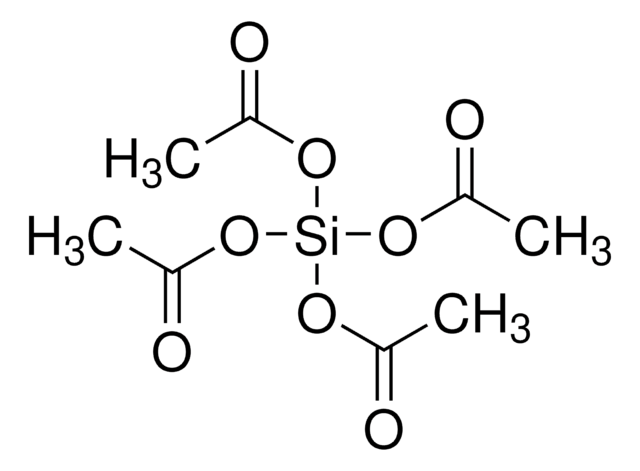759414
Tetraethylorthosilicat
packaged for use in deposition systems
Synonym(e):
Tetraethylorthosilikat, Orthokieselsäure-Tetraethylester, TEOS, Tetraethoxysilan
About This Item
Empfohlene Produkte
Dampfdichte
7.2 (vs air)
Dampfdruck
<1 mmHg ( 20 °C)
Assay
≥99.5% (GC)
Form
liquid
Brechungsindex
n20/D 1.382 (lit.)
bp
168 °C (lit.)
Dichte
0.933 g/mL at 20 °C (lit.)
SMILES String
CCO[Si](OCC)(OCC)OCC
InChI
1S/C8H20O4Si/c1-5-9-13(10-6-2,11-7-3)12-8-4/h5-8H2,1-4H3
InChIKey
BOTDANWDWHJENH-UHFFFAOYSA-N
Suchen Sie nach ähnlichen Produkten? Aufrufen Leitfaden zum Produktvergleich
Anwendung
- Si oxide
- Oxycarbide
- Doped silicate
- Silanol
- Siloxane polymer
- Organosilicon thin films
The films can be deposited at low temperatues (<250 °C). TEOS is also used to deposit mesoporous and nanoporous thin films of silica. These porous films can be doped during deposition to further enhance their properties.
Signalwort
Warning
H-Sätze
Gefahreneinstufungen
Acute Tox. 4 Inhalation - Eye Irrit. 2 - Flam. Liq. 3 - STOT SE 3
Zielorgane
Respiratory system
Lagerklassenschlüssel
3 - Flammable liquids
WGK
WGK 1
Flammpunkt (°F)
113.0 °F - closed cup
Flammpunkt (°C)
45 °C - closed cup
Analysenzertifikate (COA)
Suchen Sie nach Analysenzertifikate (COA), indem Sie die Lot-/Chargennummer des Produkts eingeben. Lot- und Chargennummern sind auf dem Produktetikett hinter den Wörtern ‘Lot’ oder ‘Batch’ (Lot oder Charge) zu finden.
Besitzen Sie dieses Produkt bereits?
In der Dokumentenbibliothek finden Sie die Dokumentation zu den Produkten, die Sie kürzlich erworben haben.
Kunden haben sich ebenfalls angesehen
Unser Team von Wissenschaftlern verfügt über Erfahrung in allen Forschungsbereichen einschließlich Life Science, Materialwissenschaften, chemischer Synthese, Chromatographie, Analytik und vielen mehr..
Setzen Sie sich mit dem technischen Dienst in Verbindung.





![[Pd(OAc)2]3 reagent grade, 98%](/deepweb/assets/sigmaaldrich/product/structures/508/249/99a0ef2c-b77c-4d73-8ed9-0cca05b6b41f/640/99a0ef2c-b77c-4d73-8ed9-0cca05b6b41f.png)




